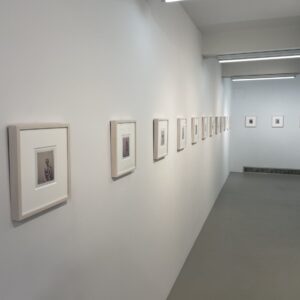JTF (just the facts): A total of 32 black and white photographs, framed in black and matted, and hung in the entry area, front room, main gallery space and back room. All of the photographs are vintage or early gelatin silver prints, taken between 1917 and 1936. Physical dimensions range from roughly 5×4 to 16×12 or reverse. A catalog of the exhibit is available from the gallery. (Installation shots at right.)
Comments/Context: The photographs that Constantin Brancusi made of his sculpture and studio are much more than static evidentiary documents of end product art objects and an overfilled workshop space. They do something quite a bit more radical, employing photography as an expressive method to entirely reinterpret these iconic works, using the interchange of light and shadow to expand our perception of the sculpted forms. Picking up from the small selection of Brancusi photographs in the Original Copy show at MoMA two years ago (review here), this show goes further in exploring how Brancusi used his camera to carefully control and expand our experience of his own work, in the process making photographs that stand on their own as fully formed artworks.
Brancusi’s images of individual sculptures show him experimenting with reflected light, shadow, glare, viewing angle, scale, background color, and even multiple exposures to heighten our awareness of texture, form, and drama. Several of the rough wooden sculptures are lit with harsh direct light, turning the three dimensional objects into flat two dimensional shapes in dark black, echoed by multiple shadows on nearby walls. Sculptures made of brass/bronze and other shiny metals capture brilliant flashes of brightness and energy, or reflect artist’s tripod in hidden self-portraits. Ovoid marble objects become soft and silky, or turn and pose amid lengthy shadows. An upwards view of one of his famous Endless Columns turns the bumpy totem into an angular thrust skyward. And Brancusi’s series of thin, elongated vertical birds are transformed by all these visual effects in turn: black birds with white highlights, white birds with multiple black shadows, and golden birds with radiant glints.
Brancusi’s wider studio views go beyond the singular attention paid to individual works and explore a deeper sense of spatial interaction between the various sculptures, pedestals, bases, and other objects in the workshop. Pairings accent contrasts of shape, form, and weight (thin and thick), while wider views mix scales into a dizzying jumble of blocky geometric forms and more refined objects. Textures overlap, and the natural light from the overhead windows brings areas of light and dark to the carefully arranged installations. When flattened into two dimensions by the camera, the studio views become complex abstract compositions, filled with interlocking relationships and spatial connections, with particular resonance in the shifting back and forth layering between figure and ground.
While these photographs were certainly successful in increasing (or reinforcing) my appreciation for Brancusi’s talents with a chisel or an axe, I think the pictures definitively show that Brancusi was equally adept at controlling mood and emphasis with his camera. This is a well-edited gathering of deceptively complicated vintage photographs, well worth the time spent to savor their intricacies.
Collector’s POV: The prices for the prints in this show range from $45000 to $250000. Over the past decade, Brancusi’s photographic work has been intermittently available in the secondary markets, with roughly a handful of lots up for sale in any given year. Recent prices at auction have ranged between $5000 and $84000.









Brancusi was the second greatest sculptor of the last century. FACT. That said, I would LOVE to meet the dolt who pays $45000 for one of his photographs.